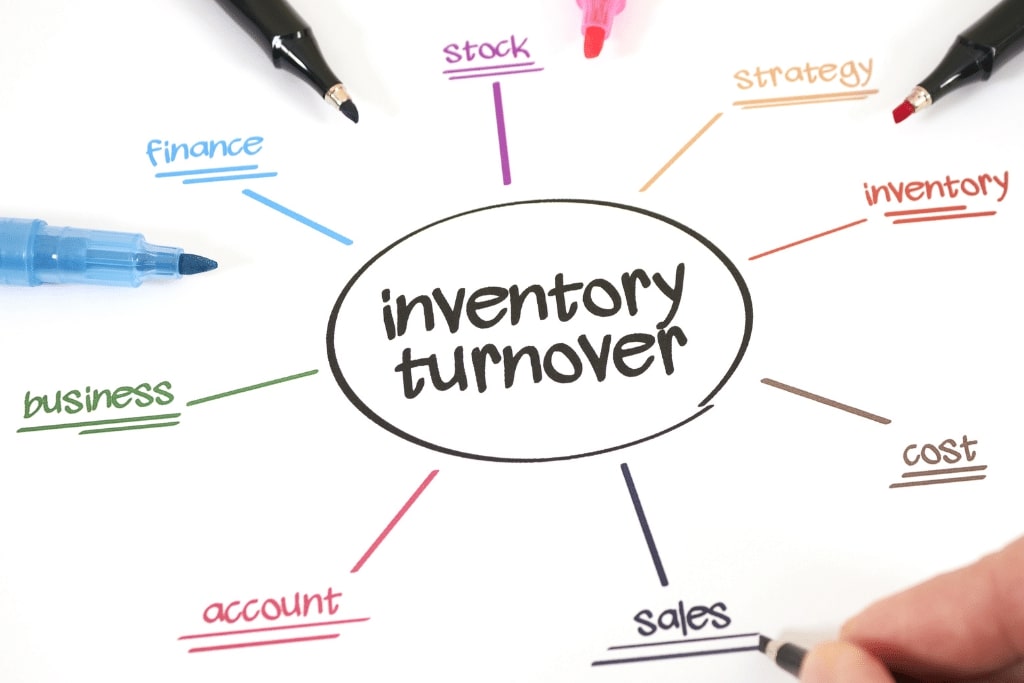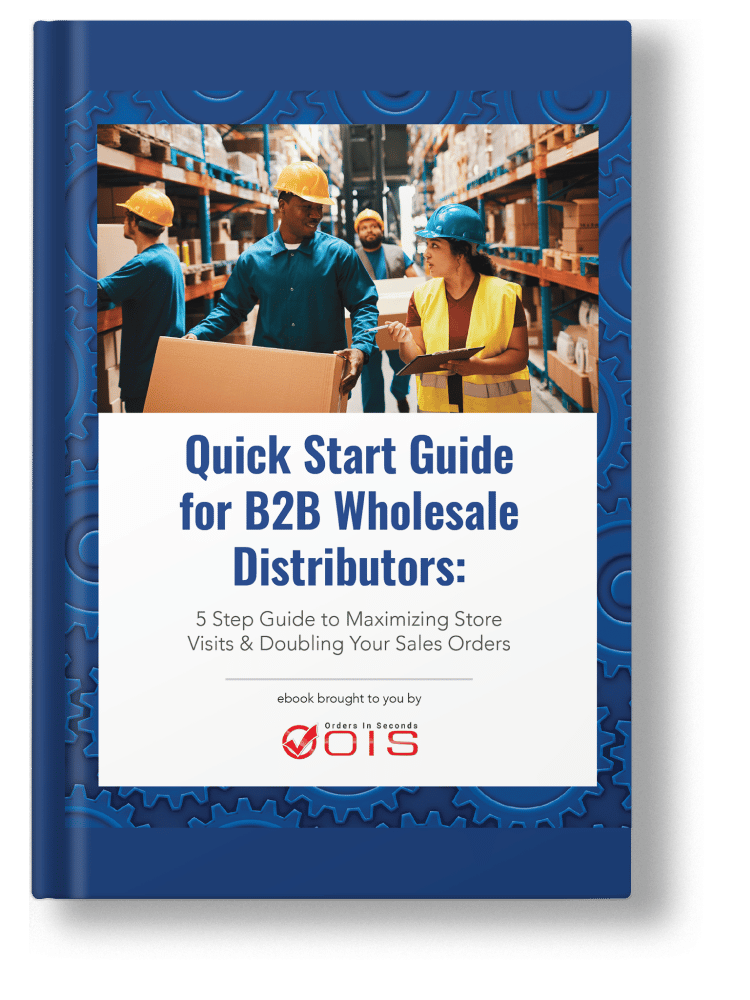Key Takeaways
Inventory turnover ratio shows how often a business sells and replaces its inventory over a period. This metric is vital for evaluating operational efficiency. In this article, we will explain its meaning, importance, and calculation.
- The inventory turnover ratio is a key metric that evaluates a company’s efficiency in managing and selling its inventory, reflecting the frequency of sales and replacement over a particular period.
- Calculating the inventory turnover ratio involves dividing the Cost of Goods Sold (COGS) by the average inventory, providing insights into operational effectiveness and helping businesses optimize their inventory management strategies.
- High inventory turnover indicates strong sales and effective management, while low turnover suggests overstocking or decreased demand, necessitating a review of inventory strategies and market dynamics.
Table of Contents
- Understanding Inventory Turnover Ratio
- Calculating Inventory Turnover Ratio
- Analyzing Inventory Turnover Ratios
- Industry-Specific Inventory Turnover Benchmarks
- Improving Inventory Turnover Ratio
- Inventory Turnover Ratio Calculator
- Case Studies: Real-World Applications
- Summary
- Frequently Asked Questions
- Support Your Warehouse Operations with OIS Inventory App
Understanding Inventory Turnover Ratio

The inventory turnover ratio measures how often a business sells its inventory. It also reflects how frequently inventory is replaced during a specific period. This metric is crucial for assessing a company’s operational efficiency and sales performance, as it indicates how well the business is managing its stock levels in relation to its sales. Understanding and optimizing this ratio allows businesses to make informed decisions about inventory supply, pricing strategies, and future financial planning.
A good inventory turnover ratio is crucial for effective inventory management. This ratio can fluctuate over time, necessitating continuous evaluation and adjustment to meet market demands.
Technology has significantly improved inventory management efficiency, making it easier to track and manage stock levels without relying on cumbersome spreadsheets.

Speed Up Your Warehouse Operations
A Simple Guide: How to Label Your Warehouse Bin Locations
What does inventory turnover mean?
Inventory turnover is a financial ratio that measures how quickly a company sells and replaces its inventory. A higher inventory turnover ratio generally indicates strong sales and efficient inventory management. Conversely, a lower ratio might suggest slow sales, excess inventory, or poor inventory management.
Inventory Turnover Equation
The formula to calculate inventory turnover is:
Inventory Turnover Ratio = Cost of Goods Sold / Average Inventory
- Cost of Goods Sold (COGS): The direct costs incurred in producing goods or services.
- Average Inventory: The average value of inventory held during a specific period (often a year)
Importance of Inventory Turnover
Measuring inventory turnover helps businesses gauge the efficiency of their supply chains and understand product demand. Effective inventory turnover ratios indicate market demand and guide strategic decisions on pricing and inventory mix. A high inventory turnover ratio signifies good sales performance and effective inventory management, ensuring products do not sit idle on shelves.
Conversely, a low inventory turnover ratio can indicate decreased market demand, potentially leading to changes in pricing and inventory strategy. Monitoring inventory turnover helps companies manage carrying costs, including expenses related to purchasing and storing stock.
Calculating inventory turnover helps businesses optimize operations, improve supply chain performance, and prevent obsolete stock.
What does inventory turnover show?
- Sales Efficiency: A high turnover ratio indicates that a company is selling its inventory quickly.
- Inventory Management: It reflects how effectively a company manages its inventory levels.
- Capital Efficiency: A higher turnover means less capital is tied up in inventory, improving cash flow.
- Product Demand: It can provide insights into the popularity and demand for products.
Calculating Inventory Turnover Ratio

Calculating the inventory turnover ratio is a straightforward process that involves understanding its key components: Cost of Goods Sold (COGS) and average inventory value. The ratio reflects how often a business replaces its inventory concerning its cost of goods sold over a specified timeframe. This calculation can be performed monthly, quarterly, or annually, depending on the business’s needs and the nature of its operations.
Gather data on your total COGS and average inventory over the given period to calculate the inventory turnover ratio. An example calculation might involve using $200,000 for COGS and $50,000 for average inventory, resulting in a ratio of 4.
This inventory ratio offers valuable insights into how efficiently a business manages its inventory levels relative to its sales performance.
Cost of Goods Sold (COGS)
Cost of Goods Sold (COGS) refers to the direct costs incurred in producing goods sold by a company, which includes expenses for raw materials and direct labor. The primary components of COGS are raw materials, labor costs, and any additional direct costs associated with production. To calculate COGS, use the formula: Beginning Inventory + Purchases – Ending Inventory. This calculation helps determine the total cost directly tied to the goods sold during a specific period.
COGS plays a critical role in calculating the inventory turnover ratio, as it indicates how quickly inventory is sold. Miscalculating COGS can lead to incorrect inventory turnover ratios, potentially affecting business decisions. Common pitfalls include using incorrect methods like FIFO or LIFO and not accounting for discounts or returns properly.
Accurate COGS calculations are crucial for reliable inventory management and financial planning.
Average Inventory Value
Average inventory is calculated by taking the sum of the beginning and ending inventory values and dividing by two. For example, the average inventory for Cherry Woods Furniture is $16,000.
Knowing the average inventory value is vital for managing stock levels and cash flow effectively, as it provides a more accurate view of inventory over time and helps smooth out fluctuations.
Integrating Weeks of Supply (WOS)
Complementing this, the Weeks of Supply (WOS) formula is another vital tool for inventory management. While the inventory turnover ratio shows how frequently inventory is sold and replaced, WOS helps determine how long your current stock will last based on average weekly sales. Together, these formulas provide a comprehensive view of your inventory’s health, allowing for more precise planning and decision-making.
Asset Turnover Ratio Measures
The asset turnover ratio measures how efficiently a company uses its assets to generate sales or revenue over a specific period. This turnover ratio is a vital indicator of operational effectiveness, showing how well a company’s assets are being put to work. To calculate the asset turnover ratio, simply divide the company’s net sales by its average total assets for the period.
A higher asset turnover ratio means the company is generating more sales from each dollar invested in assets, reflecting efficient use of resources. Conversely, a lower ratio may signal that assets are underutilized or that the company’s operations are not as effective as they could be. For example, if a company has net sales of $500,000 and average total assets of $250,000, its asset turnover ratio would be 2. This means the company generates $2 in sales for every $1 of assets it owns.
By regularly monitoring the asset turnover ratio, companies can identify trends, benchmark against industry standards, and make informed decisions to improve how efficiently they generate revenue from their assets.
Differentiating Inventory Turnover and Asset Turnover
While both inventory turnover and asset turnover ratios are essential for evaluating a company’s efficiency, they focus on different aspects of operations. The inventory turnover ratio measures how often a company sells and replaces its inventory within a specific period, providing insight into inventory management and sales performance. In contrast, the asset turnover ratio measures how efficiently a company uses all of its assets—not just inventory—to generate revenue.
Understanding the distinction between these ratios is crucial for making informed decisions. Inventory turnover helps companies analyze how quickly products move through their supply chain, while asset turnover offers a broader perspective on how well the company’s entire asset base supports revenue generation. By evaluating both ratios, businesses can pinpoint strengths and weaknesses in their operations and develop strategies to improve overall efficiency.
How Asset Turnover Complements Inventory Metrics
The asset turnover ratio complements inventory metrics by offering a wider lens on operational efficiency. While inventory turnover focuses on how quickly inventory is sold, the asset turnover ratio reveals how well a company’s total assets are being used to generate sales. By analyzing both ratios together, companies gain a comprehensive understanding of their ability to generate sales from both inventory and other assets.
This dual analysis allows businesses to identify areas where they excel and where there’s room for improvement. For example, a company with a high inventory turnover but a low asset turnover may need to evaluate how other assets are being utilized. By leveraging both metrics, companies can make strategic decisions to optimize operations, improve asset utilization, and ultimately drive more efficient sales growth.
Analyzing Inventory Turnover Ratios

Analyzing inventory turnover ratios is crucial for understanding a company’s inventory management efficiency and sales performance. The ratio serves as an efficiency measure, highlighting how well a company utilizes its inventory to generate sales. Comparing turnover ratios across different periods and industries allows businesses to gain insights into their operational effectiveness and identify areas for improvement.
The average turnover rate varies significantly based on industry characteristics and demand dynamics. High turnover industries typically experience faster sales and more efficient inventory management compared to low turnover industries. These variations help businesses set realistic benchmarks and goals for their inventory turnover ratios.
High Inventory Turnover Ratio
A high inventory turnover ratio suggests effective inventory management and strong product demand. A high inventory turnover ratio generally indicates strong sales and efficient inventory management. For eCommerce retailers, aiming for a high inventory turnover rate helps in reducing carrying costs. However, businesses must find a balance, as an excessively high turnover can lead to stockouts and missed sales opportunities.
A very high inventory turnover ratio can signal potential supply shortages, leading to missed sales opportunities. Constant replenishment of inventory can result in stockouts of popular items, causing weeks of lost sales. Thus, businesses must find a balance in inventory turnover to avoid potential risks while maintaining efficient sales.
If mistakes are holding back your wholesale distribution business, download our free eBook “Avoid the Top 5 Mistakes Wholesale Distributors Make” and discover key strategies to optimize your operations for success!

Avoid the Top 5 Mistakes Wholesale Distributors Make
Low Inventory Turnover Ratio
A low inventory turnover ratio can indicate weak sales and/or decreasing market demand. Overstocking is a common cause of a low inventory turnover ratio, often resulting in higher warehouse costs and inefficiencies. Seasonal businesses and those selling expensive items are particularly affected by low inventory turnover. Maintaining excessive inventory can negatively drive cash flow and lead to serious financial issues.
Businesses should conduct an inventory analysis, evaluate their pricing strategy, and adapt purchasing policies to address low turnover. Identifying the root causes of low inventory turnover allows companies to implement targeted strategies to improve their turnover rates and overall financial health.
Industry-Specific Inventory Turnover Benchmarks

Inventory turnover ratios can vary significantly by industry. Comparing inventory turnover ratios to industry benchmarks provides valuable insights. It helps in accurately assessing performance. The ideal inventory turnover ratio for most industries typically ranges from 5 to 10. For example, Walmart turns its inventory every 42 days, illustrating the frequency at which high-volume, low-margin industries operate.
Understanding these benchmarks allows businesses to set realistic goals and adjust their inventory management strategies accordingly. By comparing turnover ratios within the same industry, companies can identify areas for improvement and optimize their stock levels to meet industry standards.
Benefits of Higher Asset Utilization
Achieving a higher asset turnover ratio is a strong indicator that a company is making the most of its assets to generate sales and revenue. Companies with a higher asset turnover ratio are typically more efficient in their operations, which can lead to increased revenue, improved profitability, and stronger returns on investment. This efficiency often translates into a competitive edge within the industry, as these companies can generate more sales without needing to invest heavily in additional assets.
A higher asset turnover ratio also suggests effective asset management, which can result in cost savings and better cash flow. By maximizing the productivity of their assets, companies can reduce waste, lower operating costs, and respond more quickly to market opportunities. Ultimately, focusing on improving the asset turnover ratio helps companies achieve sustainable growth, enhance financial performance, and maintain a leading position in their industry.
Retail vs. Manufacturing
Retail businesses usually have a higher inventory turnover due to quicker sales cycles compared to manufacturing industries. For instance, a clothing retailer with a COGS of $160,000 and average inventory of $20,000 would have an inventory turnover ratio of 8. In contrast, an automotive parts store with a COGS of $500,000 and average inventory of $10,000 would have a turnover ratio of 50, demonstrating the rapid inventory movement in high-demand sectors.
Manufacturing industries typically experience lower inventory turnover ratios due to longer production cycles and higher raw material costs. For example, a business with a COGS of $200,000 and an average inventory of $50,000 would have a turnover ratio of 4.
These differences are crucial for setting realistic benchmarks and optimizing inventory management strategies based on industry-specific dynamics.
Seasonal Fluctuations
Adjusting inventory strategies during seasonal demand changes is crucial for maintaining an efficient turnover rate. Seasonal patterns directly influence inventory levels, leading to potential mismatches between supply and demand. Anticipating these fluctuations and adjusting inventory and staffing based on expected demand increases or decreases helps businesses maintain optimal stock levels and avoid excess inventory or stockouts.

Improving inventory turnover ratio is vital for maintaining optimal stock levels, enhancing cash flow, and minimizing holding costs. Numerous companies have enhanced their profitability significantly by focusing on improving their inventory turnover rates. Strategies to improve inventory turnover include better inventory forecasts, adjusting prices, and boosting demand with marketing.
The inventory turnover ratio calculator aids businesses in simulating various scenarios to refine their inventory management strategies. By analyzing historical data and industry benchmarks, companies can identify areas for improvement and implement targeted strategies to optimize their inventory turnover ratios.
On the other hand, remember that it’s beneficial to monitor Weeks of Supply (WOS) alongside turnover. WOS helps identify the best times to reorder stock, ensuring you maintain balanced inventory levels and avoid potential pitfalls like stockouts or excess inventory.
Just-in-Time (JIT) Inventory Management
JIT inventory management improves turnover by reducing overall inventory and minimizing product holding costs. A JIT approach involves ordering inventory based on immediate demand, thus minimizing excess stock and reducing holding costs.
Maintaining just enough stock to meet demand with quick replenishment allows businesses to manage inventory risk effectively and achieve higher inventory turnover ratios.
Enhancing Demand Forecasting
Accurate demand forecasting is a key factor in achieving high inventory turnover. Historical sales data is vital for improving demand forecasts and adjusting inventory levels accordingly.
Incorporating seasonal patterns in demand forecasting helps businesses anticipate fluctuations and maintain optimal stock levels, thereby enhancing inventory turnover.
Streamlining Supply Chain Operations
A low inventory turnover ratio often points to excess inventory, which can result in increased storage costs and cash flow constraints. Weaknesses in the supply chain can lead to increased lead times, adversely affecting inventory turnover rates. End-to-end visibility is essential for spotting roadblocks in the supply chain and optimizing inventory management.
Separating long-term and short-term storage can enhance turnover ratios and save costs. For instance, it might be cheaper to keep bulk inventory separate from third-party logistics, as fulfillment centers are designed for quick turnover, unlike warehouses for storage.
Tools that provide automatic reorder notifications and consolidate warehouse forecasting assist with timely inventory replenishment and improve inventory turnover.
The inventory turnover ratio calculator helps businesses model different scenarios and optimize their inventory management. Inputting the cost of goods sold and average inventory value allows companies to quickly calculate inventory turnover ratio and gain insights into their inventory management efficiency.
How to Use the Calculator
To utilize an inventory turnover ratio calculator, input the cost of goods sold (COGS) and the average inventory value into the designated fields. Most calculators offer options to analyze historical data, helping to compare turnover rates over different periods.
Some advanced calculators can provide additional insights, such as optimal inventory levels based on industry benchmarks, assisting businesses in refining their inventory management strategies.
Example Calculation
Consider an example where the cost of goods sold is $10,000, and the average inventory is $2,000. Inputting these values into the calculator yields an inventory turnover rate of 5, indicating that the inventory was sold and replaced five times during the given period.
This example illustrates how specific inputs of COGS and inventory affect the turnover ratio outcome, providing a clear understanding of the business’s inventory efficiency.
Case Studies: Real-World Applications
Real-world applications demonstrate how effective management of inventory turnover can lead to enhanced business performance and profitability. For instance, a retail company achieved a high inventory turnover ratio by implementing an efficient supply chain strategy that minimized overstock and aligned inventory with demand.
On the other hand, a manufacturing firm optimized its inventory turnover by adopting better demand forecasting practices and streamlining supply chain operations, resulting in reduced holding costs.
These case studies show that companies across sectors can significantly improve their performance through strategic management of inventory turnover ratios. Learning from these examples allows businesses to adopt similar strategies to enhance their inventory management and achieve better financial outcomes.
Retail Success Story
A retailer with over $10 billion in sales improved inventory turnover by 25% by implementing new governance strategies and clustered product assortments. Zara’s inventory turnover rate averages around 17 times annually, showcasing their efficient supply chain model that rapidly responds to consumer demand.
Amazon utilizes advanced algorithms for inventory management, achieving an inventory turnover rate exceeding 10 times per year, supporting its e-commerce leadership. These examples highlight how leading retailers optimize their inventory management to maintain high turnover rates and drive business performance.
Manufacturing Efficiency
Ford has implemented lean manufacturing to optimize inventory turnover, resulting in significant cost savings and enhanced profitability. Manufacturers can enhance inventory turnover by adopting needs-based inventory planning and assigning specific SKUs to storage locations for improved flow.
Optimizing supply chain management is crucial for improving inventory turnover, as it directly affects how efficiently inventory is managed. These strategies help manufacturing companies maintain optimal stock levels and meet customer demand effectively.
Summary
Mastering the inventory turnover ratio is vital for any business aiming to optimize its inventory management and improve profitability. By understanding how to calculate and analyze this ratio, businesses can make informed decisions about their inventory levels, pricing strategies, and supply chain operations. Implementing strategies like JIT inventory management, enhancing demand forecasting, and streamlining supply chain operations can significantly improve inventory turnover rates. Ultimately, a well-managed inventory turnover ratio contributes to better financial health and operational efficiency.
Frequently Asked Questions
The inventory turnover ratio indicates how often a company sells and replenishes its stock over a specific period, highlighting the efficiency of inventory management. A higher ratio typically reflects effective sales and inventory control.
Cloud Inventory’s headquarters is located in Kansas City, where their global team focuses on providing supply chain solutions with mobile-first development expertise.
To calculate the inventory turnover ratio, simply divide the cost of goods sold (COGS) by the average inventory value. This provides insight into how efficiently a company is managing its inventory.
Why is a high inventory turnover ratio beneficial?
A high inventory turnover ratio is beneficial because it reflects strong sales performance and effective inventory management, leading to reduced carrying costs and less excess stock. This efficiency bolsters overall profitability and operational effectiveness.
A low inventory turnover ratio poses risks such as weak sales, excess inventory, and increased storage costs, which can ultimately strain cash flow. It’s crucial to monitor this ratio to avoid these potential financial pitfalls.
To improve their inventory turnover ratio, businesses should adopt Just-In-Time (JIT) inventory management, enhance demand forecasting, and streamline supply chain operations. These strategies lead to more efficient inventory management and higher turnover rates.
Support Your Warehouse Operations with OIS Inventory App
A well-managed warehouse is crucial for maintaining smooth inventory flow and timely order fulfillment. The OIS Inventory App helps your team improve picking efficiency, minimize errors, and keep your operations running seamlessly. Enhance your warehouse processes to support better inventory management and turnover rates.
Explore the OIS Inventory App to optimize your warehouse and inventory processes today!






